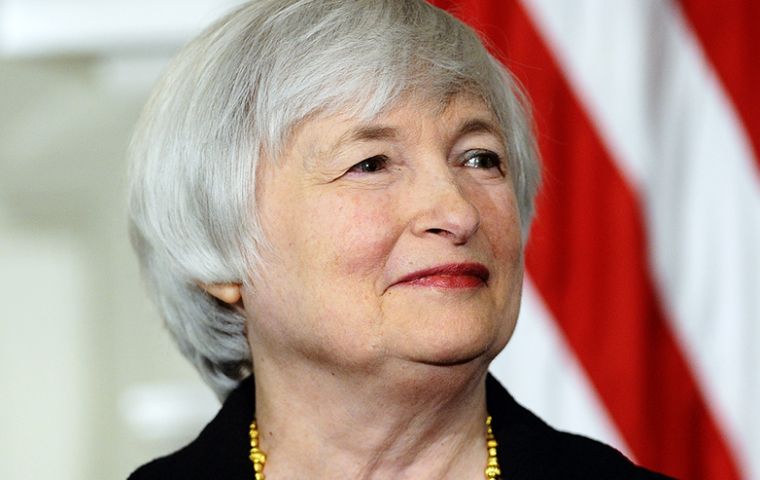MercoPress. South Atlantic News Agency
Fed optimistic about US economy; pares securities purchases by another 10bn dollars
 The report following the two day meeting chaired by Janet Yellen was unanimous
The report following the two day meeting chaired by Janet Yellen was unanimous The Federal Reserve looked past a dismal reading on first quarter US growth and gave a mostly upbeat assessment of the economy's prospects as it announced another cut in its massive bond-buying stimulus. Latest information indicates that economic activity has picked up after having slowed sharply during the winter in part because of adverse weather conditions, the central bank said on Wednesday.
And as expected, the Fed announced after a two-day meeting of its policy-making committee that it would pare its purchases of US Treasury and mortgage-backed securities by another 10 billion dollars, to 45 billion a month beginning in May.
“Growth in economic activity has picked up recently, after having slowed sharply during the winter in part because of adverse weather conditions,” the Federal Open Market Committee said in the statement announcing the unanimous decision.
The statement, while affirming the Fed’s intent to stop buying bonds later this year, offered no new insight into the next decision the Fed must make: when to start raising short-term interest rates, which it has held near zero since December 2008.
There was, however, a hint that the Fed’s deliberations were more interesting than its declaration. The Fed also said on Wednesday that its board held an unscheduled meeting Tuesday morning to discuss “medium-term monetary policy issues.”
The last such meetings, in 2011, were followed by an announcement of the Fed’s plans for the retreat that is now in progress. Officials have said that some adjustments are necessary, and analysts said they expected more information on the discussions in an account of the meeting the Fed will release in three weeks.
The Fed’s chairwoman, Janet L. Yellen, said in a recent speech that the Fed was focused on three issues in determining how much longer to suppress interest rates, and how quickly to return rates to a level closer to the historical norm. She named the extent of slack in the labor market, the sluggish pace of inflation, and the chances that growth would be undermined by unexpected events, as has happened repeatedly since the end of the Great Recession, and most recently during a season of freezes and snowstorms that chilled buying and selling across a broad swath of the US.
The Fed has largely discounted the US economy’s slow growth during the winter months in charting its retreat. The government said on Wednesday that the economy grew just 0.1% during the first three months of the year. Officials have concluded the slowdown was largely a result of the unusually cold weather.
The FOMC has reduced monthly bond purchases by 10 billion at each meeting since December, reducing the volume of purchases to 55 billion in April from 85 billion each month last year. It is on pace to end the purchases with a single cut of 15 billion when the policy committee meets in October, or a final cut of 5 billion in December.
It has been less clear about what happens next. Indeed, officials decided in March to preserve some ambiguity about the timing of a first increase in interest rates, substituting a vague description of economic goals in place of a commitment to wait at least as long as unemployment was above 6.5%. The Fed also has left some uncertainty about its plans for its bond holdings; its portfolio has swelled fourfold to more than 4 trillion dollars since the financial crisis.




Top Comments
Disclaimer & comment rules-

-

Read all commentsThe dollar is sliding against the pound. :o)
May 01st, 2014 - 03:57 pm 0It has been for awhile. I used to go to London for long weekends but that's out for a while! It just not worth the conversion.
May 02nd, 2014 - 12:16 pm 0Commenting for this story is now closed.
If you have a Facebook account, become a fan and comment on our Facebook Page!